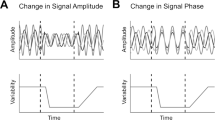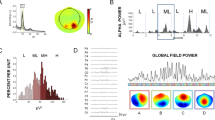Abstract
An experimental set-up and a method of analysis are described which permit the performance of e.e.g. analysis under contingent negative variation (c.n.v.) conditions with repeated stimulation. Investigations of six subjects showed a significant reduction in the average power in the alpha band immediately after the imperative stimulus, which lasted only about 1 second. In the interstimulus interval during the c.n.v. a less marked power reduction could be observed. Since the reduction of the average power in the alpha band was approximately the same for both hemispheres and since it was also dependent on the modality of the stimulus, an interrelation-ship is assumed between the directed attention and the reduction observed. This appears to allow the possibility of objectively analysing cortical functions by means of an analysis of scalp recordings under c.n.v. conditions.
Sommaire
L'article décrit un montage expérimental et une méthode d'analyse qui permet d'effectuer l'analyse de l'E.E.G. sous des conditions de variations négatives continues avec stimulations répétées. Les travaux sur six sujets révélèrent une réduction significantive de la puissance moyenne de la bande alpha immédiatement après le stimulus impératif, qui dura environ 1 seconde. Dans l'intervalle inter-stimulus, au cours des variations négatives continues, une réduction de la puissance moins marquée put être observée. Comme la réduction de la puissance moyenne dans la bande alpha était environ la même pour les deux hémisphères et comme elle dépendait aussi du mode de stimulus, une relation est présumée entre l'attention dirigée et la réduction observée. Ceci semble permettre d'analyser objectivement les fonctions corticales à l'aide d'une analyse des enregistrements du cuir chevelu dans des conditions de variations négatives continues.
Zusammenfassung
Es werden ein experimentelles Beispiel und ein Analyseverfahren beschrieben, die die Durchführung einer EEG-Analyse unter sich ständig negativ veränderten Bedingungen bei wiederholter Stimulation gestatten. Untersuchungen an sechs Patienten zeigten einen bedeutenden Rückgang der durchschnittlichen Leistung im Alphaband direkt nach dem zwingenden Stimulus, der nur etwa 1 Sekunde dauerte. In der Pause zwischen den Stimuli während der ständig negativen Veränderung wurde eine weniger bedeutende Leistungsminderung beobachtet. Da die Minderung der Durchschnittsleistung im Alphaband für beide Hemisphären etwa gleich war und da sie ferner von der Modalität des Stimulus abhing, wird eine Wechselbeziehung zwischen der richtungs-bezogenen Aufmerksamkeit und der beobachteten Abschwächung angenommen. Das scheint die Möglichkeit einer objektiven Analyse der kortikalen Funktionen durch eine Analyse der Kopfhautaufzeichungen unter sich ständig negativ ändernden Bedingungen zuzulassen.
Similar content being viewed by others

References
Chatrian, G. E., Petersen, M. C. andLazarte, J. A. (1959) Blocking of the Rolandic-Wicked rhythm and some central changes related to movement.Electroenceph. Clin. Neurosphysiol. 11, 497–510.
Dumermuth, G. andFlühler, H. (1967) Some modern aspects in numerical spectrum analysis of multichannel electroencephalographic data.Med. & Biol. Engng. 5, 319–331.
Kornhuber, H. andDeecke, L. (1965) Hirnpotentialänderungen bei Willkürbewegungen und passiven Bewegungen des Menschen: Bereitschaftspotential und reafferente Potentiale.Pflügers Arch. Ges. Physiol. 284, 1–17.
Krönig, D., Künkel, H. andSchulze, J. (1971) Computerauswertung von Biosignalen in der Schwerkrankenüberwachung.Proc. IFAC Symposium: Automatic control and computers in the medical field, Brüssel 1971, 57–59.
McCallum, W. C. andWalter, W. G. (1968) The effects of attention and distraction on the contingent negative variation in normal and neurotic subjects.Electroenceph. Clin. Neurophysiol. 25, 319–329.
Papakostopoulos, D. andMcCallum, W. C. (1973) the c.n.v. and autonomic changes in situations of increasing complexity.In W. C. McCallum andJ. R. Knott (Eds.) Event-related slow potentials of the brain: their relations to behaviour.Electroenceph. Clin. Neurophysiol. Suppl. 33, (in press).
Plank, B. (1974) Entwicklung und Bau eines digitalen Signalgebers. Diplomarbeit am Institut für Elektro-und biomedizinische Technik der Technischen Hochschule in Graz.
Walter, W. G. (1964) Slow potential waves in the human brain associated with expectancy, attention and decision,Arch. Psychiat. Nervenkr. 206, 309–322.
Walter, W. G. (1967) Electrical signs of association, expectancy and decision in the human brain.Electroenceph. Clin. Neurophysiol. Suppl. 25 258–263.
Author information
Authors and Affiliations
Rights and permissions
About this article
Cite this article
Pfurtscheller, G., Waibel, R. & Schuy, S. Changes of the e.e.g. during a c.n.v. paradigm. Med. & biol. Engng. 14, 199–204 (1976). https://doi.org/10.1007/BF02478748
Received:
Accepted:
Issue Date:
DOI: https://doi.org/10.1007/BF02478748



